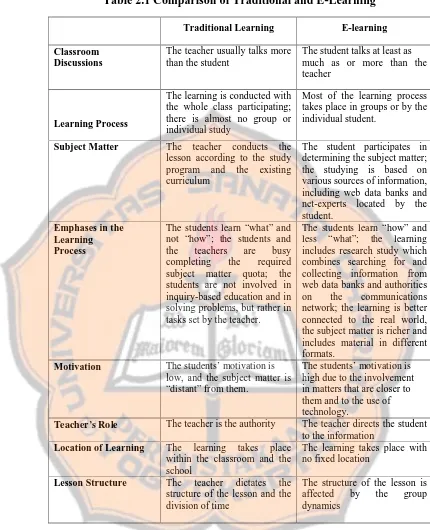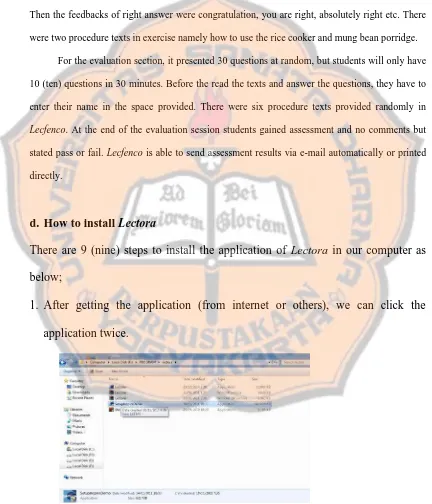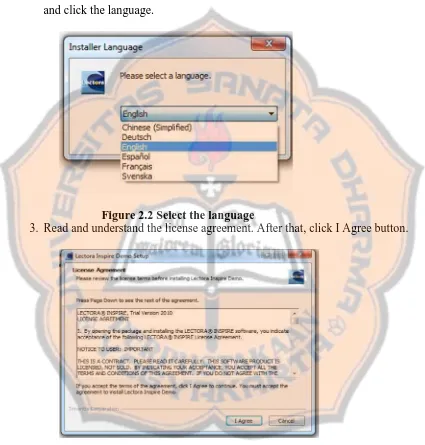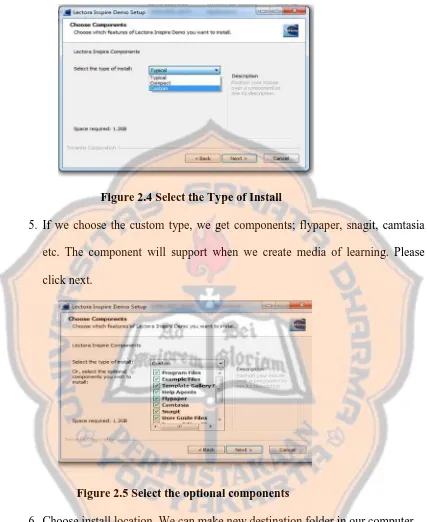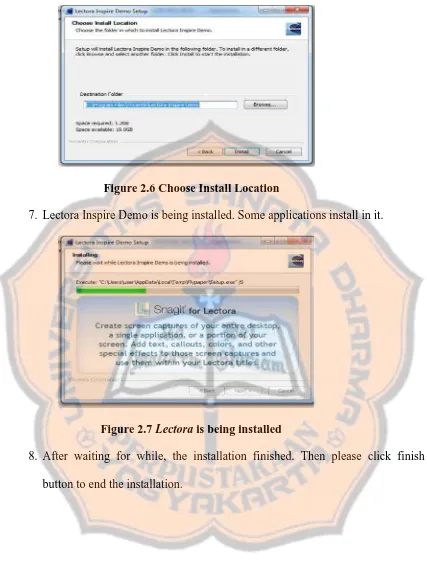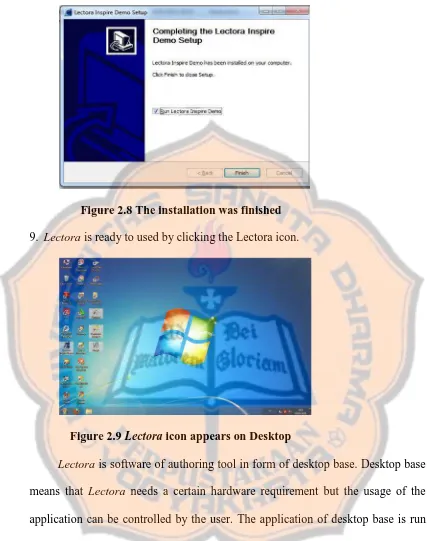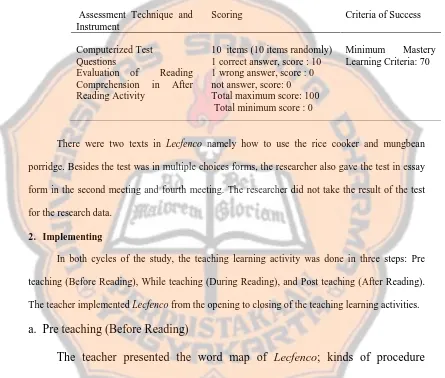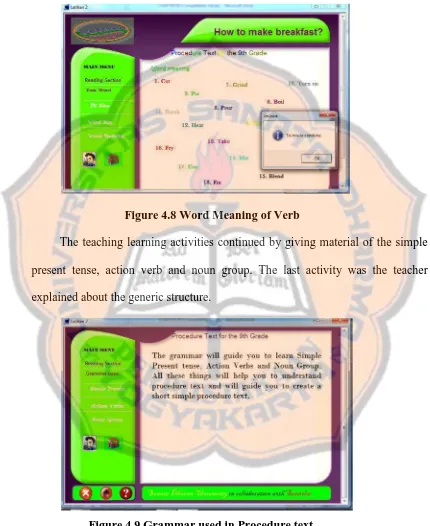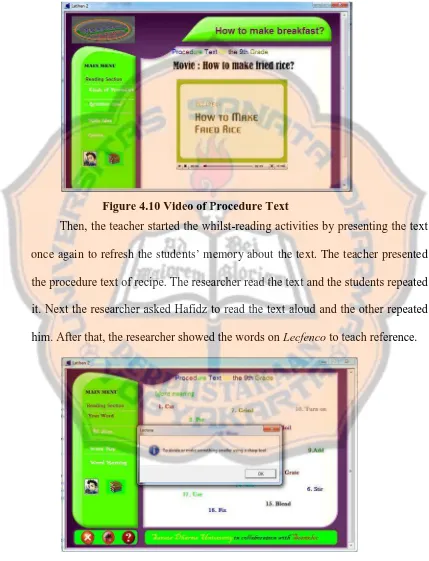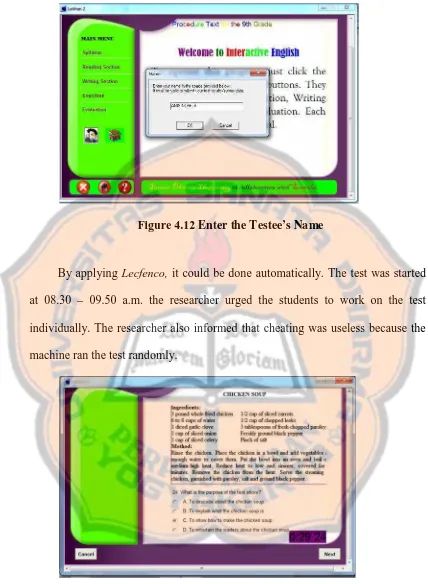ABSTRACT
Joko Sulistya. 2015. Improving Students’ Reading Comprehension through Lecfenco: A Classroom Action Research. Yogyakarta: The Graduate Program in English Language, Sanata Dharma University.
Reading comprehension still becomes a problem for students grade IX in SMPN 2 Bambanglipuro. In fact, most tests conducted in school are reading form. There are 5 (five) kinds of genre texts in the grade IX and procedure text are one of the difficult texts for students. There are seven indicators in a procedure text namely (1) determine general information, (2) find out certain information, (3) find out implicit information, (4) identify explicit information, (5) determine reference, (6) determine communicative purpose, and (7) identify word meaning. Therefore, the seven indicators have to be mastered by students of grade IX. The problem above will be solved by applying Lecfenco. Then the question of research was Can the use of Lecfenco improves the English reading comprehension of Junior High School in the 2015-2016 academic year and how can the use of Lecfenco improve the English reading comprehension?
The writer conducted classroom action research in SMPN 2 Bambanglipuro from August 2015 up to November 2015. The subjects of the research were the students of class IXD of SMPN 2 Bambanglipuro, Bantul,in the academic year of 2015-2016. The research conducted in two cycles in which in the first cycle, there were two meetings and in the second cycle, there were two meetings. The writer applied Lecfenco to teach and practice reading, especially a procedure text. There were two kinds of data: qualitative and quantitative data. The qualitative data were collected by doing observation and giving questionnaire. Then the quantitative data were collected by giving tests: pre-test, post-test in cycle 1 and post test in cycle 2. The test consisted of seven indicators as the students’ problem. The quantitative data were analyzed by descriptive statistics to calculate the mean scores of the pre test, the post test in Cycle 1, and the post test in cycle 2.
The research findings showed that Lecfenco can improve the seven indicators of procedure questions. The improvement can be seen from the
students’ mean score in pre test (54.05), post-test in Cycle 1 (70.52), and post test in Cycle 2 (77.41). Meanwhile, the minimum passing grade (KKM) was 70. Therefore, it can be concluded that (1) Lecfenco can improve the English reading comprehension of Junior High School in the 2015-2016 academic year; (2) Lecfenco can be succesful because the writer applied the steps of Lecfenco such as word map, pit stop, word meaning, grammar and etcetera in his teaching learning activity.
ABSTRAK
Joko Sulistya. 2015. Improving Students’ Reading Comprehension
through Lecfenco: A Classroom Action Research. Yogyakarta: The Graduate Program in English Language, Sanata Dharma University.
Pemahaman bacaan masih menjadi sebuah masalah bagi siswa kelas IX di SMPN 2 Bambanglipuro. Kenyataannya, banyak tes yang dilaksanakan di sekolah berbentuk bacaan. Ada 5 jenis teks yang diajarkan di kelas IX dan teks prosedur adalah salah satu teks yang sulit bagi siswa. Ada 7 indikator yang ditanyakan dalam teks prosedur yaitu (1) menentukan informasi umum, (2) menemukan informasi tertentu, (3) menemukan informasi tersirat, (4) mengidentifikasi informasi tersurat, (5) menentukan reference, (6) menentukan tujuan komunikatif, dan (7) mengidentifikasi arti kata. Oleh karena itu, tujuh indikator tersebut perlu dikuasai oleh siswa kelas IX. Masalah tersebut di atas akan dipecahkan dengan menggunkan Lecfenco. Kemudian pertanyaan penelitiannya adalah Dapatkah penggunaan Lecfecno meningkatkan kemampuan memahami bacaan siswa SMP pada tahun akademik 2015-2016 dan Bagaimanakah caranya penggunaan Lecfenco dapat meningkatkan kemampuan memahami bacaan siswa SMP pada tahun akademik 2015-2016?
Penulis melaksanakan penelitian tindakan kelas di SMPN 2 Bambanglipuro dari bulan Agustus 2015 sampai bulan November 2015. Subyek penelitian adalah siswa kelas IXD SMPN 2 Bambanglipuro, Bantul pada tahun akademik 2015-2016. Penelitian dilaksanakan dalam 2 siklus yang mana pada siklus pertama ada 2 (dua) pertemuan dan pada siklus kedua juga ada 2 pertemuan. Penulis menggunakan media Lecfenco untuk mengajar dan melatih membaca, khususnya teks prosedur. Ada 2 jenis data yaitu data kualitatif dan data kuantitatif. Data kualitatif diperoleh dengan melakukan observasi dan memberikan kuesioner. Sedangkan data kuantitatif diperoleh dengan memberikan tes; pre-tes, pos tes pada siklus 1 dan pos tes pada siklus 2. Tes terdiri dari 7 (tujuh) indikator yang menjadi masalah siswa. Data kuantitatif kemudian dianalisis dengan statistik deskriptif untuk menghitung skor rata – rata pada pre-tes, pos tes pada siklus 1 dan pos tes pada siklus 2.
Hasil penelitian menunjukkan bahwa Lecfenco dapat meningkatkan 7 (tujuh) indikator pertanyaan prosedur. Peningkatan dapat dilihat dari nilai rata – rata pada pre-tes (54.05), pos tes pada siklus 1 (70.52) dan pos tes pada siklus 2 (77.41). Sedangkan kritera ketuntasan minimal (KKM) sebesar 70. Oleh karena itu dapat disimpulkan bahwa (1) Lecfenco dapat meningkatkan kemampuan memahami bacaan bahasa Inggris siswa SMP pada tahun akademik 2015-2016 dan (2) itu berhasil karena penulis menerapkan langkah – langkah yang ada pada Lecfenco seperti word map, pit stop, word meaning, grammar dan lain – lain dalam kegiatan pembelajarannya.
A Thesis Presented to
The Graduate Program in English Language Studies in Partial Fulfilment of the Requirements
for the Degree of Magister Humaniora (M.Hum)
in
English Language Studies
by
Joko Sulistya 116332042
SANATA DHARMA UNIVERSITY YOGYAKARTA
IMPROVING STUDENTS’ READING COMPREHENSION
THROUGH LECFENCO
A Thesis Presented to
The Graduate Program in English Language Studies in Partial Fulfilment of the Requirements
for the Degree of Magister Humaniora (M.Hum)
in
English Language Studies
by
Joko Sulistya 116332042
SANATA DHARMA UNIVERSITY YOGYAKARTA
LEMBAR PERNYATAAN PERSETUJUAN PUBLIKASI KARYA ILMIAH UNTUK KEPENTINGAN AKADEMIS
Yang bertanda tangan di bawah ini, saya mahasiswa Program Pascasarjana Kajian Bahasa Inggris Universitas Sanata Dharma Yogyakarta
Nama : Joko Sulistya
Nomor Mahasiswa : 116332042
Demi pengembangan ilmu pengetahuan, saya memberikan kepada perpustakaan Universitas Sanata Dharma karya Ilmiah saya yang berjudul
IMPROVING STUDENTS’ READING
COMPREHENSION
THROUGH LECFENCO
Beserta perangkat yang diperlukan (bila ada)
Demikian saya memberikan kepada Perpustakaan Universitas Sanata Dharma hak untuk menyimpan, mengalihkan dalam bentuk media lain, mengelolanya dalam bentuk pangkalan data, mendistribusikan secara terbatas, dan mempublikasikannya di internet atau media lain untuk kepentingan akademis tanpa perlu meminta izin dari saya maupun memberi royalty kepada saya selama tetap mencantumkan nama saya sebagai penulis.
Demikian pernyataan ini saya buat dengan sebenarnya.
Dibuat di : Yogyakarta Pada tanggal : 25 Mei 2016 Yang menyatakan
ACKNOWLEDGEMENTS
Praise be Allah, Lord of the world. Only by His blessing and guidance could the writer finish this study as one of the requirements of completing the Strata 2 degree in English Language Studies at Sanata Dharma University, Yogyakarta.
Owing a lot of kindness to those who motivated and guided the writer during the process of this study, therefore, the writer would like to express his gratitude to the following persons. First and foremost, I want to thank F.X. Mukarto, M.S.,Ph.D, my thesis advisor, for his feedback and encouragement at every stage of this study. Most of all, I am grateful to his warmth, patience and continued moral support. I feel extremely fortunate to have learned from him. My deepest thank also goes to Dr.Ir. Gatot Hari
Priowirjanto and SEAMOLEC’s team for the funding and their dedication in teaching and promoting technology in education. My deepest thank also goes to ibu Dra. Denok Widarti, M.Pd, M.A, the headmistress of SMPN 2 Bambanglipuro for the permission of conducting this study in her school. I also give my greatest appreciation to ibuNurul Hidayati, S.S as the writer’s
colleague for her participation, support, and help. My special thanks go to my SEAMOLEC friends; Hebi, Siska, Uke, Dias, Risang, Daniel, Ditha. You are more than friends to me. It was wonderful moment that I never forgot when we met and learnt together. Do you think so, my brother and sister?
TABLE OF CONTENTS
TITLE... i
ADVISOR APPROVAL PAGE ... ii
DEFENSE APPROVAL PAGE... iii
STATEMENT OF ORIGINALITY ... iv
LEMBAR PERNYATAAN PERSETUJUAN PUBLIKASI KARYA ILMIAH UNTUK KEPENTINGAN AKADEMIS ... v
ACKNOWLEDGEMENTS ... vi
TABLE OF CONTENTS ... vii
LIST OF TABLES ... viii
LIST OF FIGURES ... ix
LIST OF APPENDICES ... x
ABSTRACT... xi
ABSTRAK ... xii
CHAPTER I : INTRODUCTION... 1
A. Background of the Research... 1
B. Research Problem... 10
C. Research Objectives ... 10
D. Significance of the Problem ... 10
CHAPTER II: LITERATURE REVIEW ... 12
A. English Teaching Learning Based on the Curriculum ... 12
B. National Standard of Process in English Teaching Learning Activities .... 13
C. Reading... 14
1. The Nature of Reading... 14
2. The Process of Reading ... 15
a. The bottom up model ... 15
b. The top-down model ... 16
c. The interative model ... 16
3. Techniques of Reading ... 17
4. Macro & Micro Reading Skills... 18
5. Reading Comprehension ... 20
6. Reading in the Language Classroom ... 22
7. Factors Affecting Comprehension Skills ... 23
8. Assessment of Reading Comprehension ... 25
D. E-Learning in Teaching Learning Activity ... 27
1. E-learning ... 27
2. Lecfenco as A learning media... 29
a. Theory of Electronic Media ... 29
b. Lectora ... 31
d. How to install Lectora ... 37
CHAPTER III: RESEARCH METHODS ... 42
A. Setting of Research... 42
B. Research Design ... 43
C. Research Procedure ... 48
1. Planning ... 48
2. Implementing... 54
D. Data Collection Technique ... 55
E. Data Collection Instrument ... 56
F. Data Analysis ... 57
1. Quantitative Data Analysis ... 57
2. Qualitative Data Analysis ... 59
CHAPTER IV: RESEARCH FINDINGS AND DISCUSSION ... 60
A. Research Findings ... 60
1. Students’ Reading Comprehension in Pre-test ... 60
2. Students’ Reading Comprehension in Cycle 1 ... 62
a. Planning ... 62
b. Action ... 67
c. Observation ... 79
d. Reflection ... 83
e. Summary of Finding in Cycle 1... 85
3. Students’ Reading Comprehension in Cycle 2... 87
a. Planning ... 87
b. Action ... 91
c. Observation ... 97
d. Reflection ... 100
e. Summary Finding during the Research ... 102
B. Discussion ... 107
CHAPTER V: CONCLUSION AND SUGGESTION ... 111
A. Conclusion ... 111
B. Suggestion ... 112
BIBLIOGRAPHY ... 114
LIST OF TABLES
Table 2.1 : Comparison of Traditional and E-Learning ... 28
Table 3.1 : Overview Of Research ... 48
Table 3.2 : Standard and Based Competence Of Reading Comprehension ... 49
Table 3.3 : Observation List Before, During and After Reading... 53
Table 3.4 : Scoring Of Result Assessment And Criteria Of Success... 53
Table 3.5 : Data, Data Collection and Data Collection Instrument... 56
Table 3.6 : The Criteria of the Mean Score... 58
Table 4.1 : Students’ Score Of Pre-Test ... 61
Table 4.2 : Students’Score Per Indicator... 61
Table 4.3 : The Elements Of Lesson Plan... 64
Table 4.4 : The Activities For Main Teaching Reading Comprehension .. 66
Table 4.5 : The Overall Implementation Of Cycle 1 ... 67
Table 4.6 : Students’ Score Of Post-Test In Cycle 1 ... 82
Table 4.7 : The Element Of Lesson Plan ... 89
Table 4.8 : The Activities For Main Teaching Reading Comprehension ... 90
Table 4.9 : The Overall Implementation Of Cycle 2 ... 91
Table 4.10 : The Comparison Among Students’ Reading Comprehension Score in The Pre-Test, The Post-Test in Cycle 1 and The Post-Test in Cycle 2... 103
Table 4.11 : The Comparison Among Students’ Mean Score of indicators in The Pre-test, The Post-Test in Cycle 1 and The Post-Test in Cycle 2... 104
Table 4.12 : The Improvement After Implementation... 105
LIST OF FIGURES
Figure 2.1 : Install Lectora Inspire Demo ... 37
Figure 2.2 : Select the Language ... 37
Figure 2.3 : Read and Click License Agreement ... 38
Figure 2.4 : Select the Type of Install ... 38
Figure 2.5 : Select the optional components ... 39
Figure 2.6 : Choose Install Location... 39
Figure 2.7 : Lectora is being installed ... 39
Figure 2.8 : The installation was finished ... 40
Figure 2.9 : Lectora icon appears on Desktop ... 40
Figure 3.1 : Clicking the Lectora icon ... 50
Figure 3.2 : Create the Template ... 50
Figure 3.3 : Name and Choose the Location ... 51
Figure 3.4 : Determine the Page Size ... 51
Figure 3.5 : Organize the Chapter and Page ... 52
Figure 3.6 : Template was ready... 52
Figure 4.1 :Students’ Score Of Pre-Test ... 60
Figure 4.2 : Front Page ... 69
Figure 4.3 : Main Menu of Lecfenco ... 70
Figure 4.4 : Indicators of Reading Skill... 70
Figure 4.5 : Word Map of Procedure Text... 71
Figure 4.6 : Pit Stop of Procedure Text ... 71
Figure 4.7 :Sample of Students’ work ... 72
Figure 4.8 : Word Meaning of Verb ... 73
Figure 4.9 : Grammar used in Procedure text ... 74
Figure 4.10 : Video of Procedure Text ... 75
Figure 4.11 : Synonym of Verbs... 76
Figure 4.12 :Enter the Testee’s Name ... 77
Figure 4.13 : Sample of Post-test... 78
Figure 4.14 : Result of Post test ... 78
Figure 4.15 :Students’ Score Of Post-Test in Cycle 1... 81
LIST OF APPENDICES
Appendix 1. Rencana Pelaksanaan Pembelajaran ... 1
Appendix 2. Garis Besar Isi Program Media (GBIPM) ... 11
Appendix 3. Story board of Media ... 13
Appendix 4. Lembar Pemantauan PBM di Kelas ... 24
Appendix 5. Observation Check list ... 33
Appendix 6. Soal dan Kisi–kisi Pre test ... 34
Appendix 7. Result Of Internal Validity And Reliability ... 35
Appendix 8. Analisi Hasil Post-Test... 36
Appendix 9. Results Of Data Analisis ... 38
Appendix 10. Lembar Kuesioner... 42
ABSTRACT
Joko Sulistya. 2015. Improving Students’ Reading Comprehension through Lecfenco: A Classroom Action Research. Yogyakarta: The Graduate Program in English Language, Sanata Dharma University.
Reading comprehension still becomes a problem for students grade IX in SMPN 2 Bambanglipuro. In fact, most tests conducted in school are reading form. There are 5 (five) kinds of genre texts in the grade IX and procedure text are one of the difficult texts for students. There are seven indicators in a procedure text namely (1) determine general information, (2) find out certain information, (3) find out implicit information, (4) identify explicit information, (5) determine reference, (6) determine communicative purpose, and (7) identify word meaning. Therefore, the seven indicators have to be mastered by students of grade IX. The problem above will be solved by applying Lecfenco. Then the question of research was Can the use of Lecfenco improves the English reading comprehension of Junior High School in the 2015-2016 academic year and how can the use of Lecfenco improve the English reading comprehension?
The writer conducted classroom action research in SMPN 2 Bambanglipuro from August 2015 up to November 2015. The subjects of the research were the students of class IXD of SMPN 2 Bambanglipuro, Bantul,in the academic year of 2015-2016. The research conducted in two cycles in which in the first cycle, there were two meetings and in the second cycle, there were two meetings. The writer applied Lecfenco to teach and practice reading, especially a procedure text. There were two kinds of data: qualitative and quantitative data. The qualitative data were collected by doing observation and giving questionnaire. Then the quantitative data were collected by giving tests: pre-test, post-test in cycle 1 and post test in cycle 2. The test consisted of seven indicators as the students’ problem. The quantitative data were analyzed by descriptive statistics to calculate the mean scores of the pre test, the post test in Cycle 1, and the post test in cycle 2.
The research findings showed that Lecfenco can improve the seven indicators of procedure questions. The improvement can be seen from the
students’ mean score in pre test (54.05), post-test in Cycle 1 (70.52), and post test in Cycle 2 (77.41). Meanwhile, the minimum passing grade (KKM) was 70. Therefore, it can be concluded that (1) Lecfenco can improve the English reading comprehension of Junior High School in the 2015-2016 academic year; (2) Lecfenco can be succesful because the writer applied the steps of Lecfenco such as word map, pit stop, word meaning, grammar and etcetera in his teaching learning activity.
ABSTRAK
Joko Sulistya. 2015. Improving Students’ Reading Comprehension
through Lecfenco: A Classroom Action Research. Yogyakarta: The Graduate Program in English Language, Sanata Dharma University.
Pemahaman bacaan masih menjadi sebuah masalah bagi siswa kelas IX di SMPN 2 Bambanglipuro. Kenyataannya, banyak tes yang dilaksanakan di sekolah berbentuk bacaan. Ada 5 jenis teks yang diajarkan di kelas IX dan teks prosedur adalah salah satu teks yang sulit bagi siswa. Ada 7 indikator yang ditanyakan dalam teks prosedur yaitu (1) menentukan informasi umum, (2) menemukan informasi tertentu, (3) menemukan informasi tersirat, (4) mengidentifikasi informasi tersurat, (5) menentukan reference, (6) menentukan tujuan komunikatif, dan (7) mengidentifikasi arti kata. Oleh karena itu, tujuh indikator tersebut perlu dikuasai oleh siswa kelas IX. Masalah tersebut di atas akan dipecahkan dengan menggunkan Lecfenco. Kemudian pertanyaan penelitiannya adalah Dapatkah penggunaan Lecfecno meningkatkan kemampuan memahami bacaan siswa SMP pada tahun akademik 2015-2016 dan Bagaimanakah caranya penggunaan Lecfenco dapat meningkatkan kemampuan memahami bacaan siswa SMP pada tahun akademik 2015-2016?
Penulis melaksanakan penelitian tindakan kelas di SMPN 2 Bambanglipuro dari bulan Agustus 2015 sampai bulan November 2015. Subyek penelitian adalah siswa kelas IXD SMPN 2 Bambanglipuro, Bantul pada tahun akademik 2015-2016. Penelitian dilaksanakan dalam 2 siklus yang mana pada siklus pertama ada 2 (dua) pertemuan dan pada siklus kedua juga ada 2 pertemuan. Penulis menggunakan media Lecfenco untuk mengajar dan melatih membaca, khususnya teks prosedur. Ada 2 jenis data yaitu data kualitatif dan data kuantitatif. Data kualitatif diperoleh dengan melakukan observasi dan memberikan kuesioner. Sedangkan data kuantitatif diperoleh dengan memberikan tes; pre-tes, pos tes pada siklus 1 dan pos tes pada siklus 2. Tes terdiri dari 7 (tujuh) indikator yang menjadi masalah siswa. Data kuantitatif kemudian dianalisis dengan statistik deskriptif untuk menghitung skor rata – rata pada pre-tes, pos tes pada siklus 1 dan pos tes pada siklus 2.
Hasil penelitian menunjukkan bahwa Lecfenco dapat meningkatkan 7 (tujuh) indikator pertanyaan prosedur. Peningkatan dapat dilihat dari nilai rata – rata pada pre-tes (54.05), pos tes pada siklus 1 (70.52) dan pos tes pada siklus 2 (77.41). Sedangkan kritera ketuntasan minimal (KKM) sebesar 70. Oleh karena itu dapat disimpulkan bahwa (1) Lecfenco dapat meningkatkan kemampuan memahami bacaan bahasa Inggris siswa SMP pada tahun akademik 2015-2016 dan (2) itu berhasil karena penulis menerapkan langkah – langkah yang ada pada Lecfenco seperti word map, pit stop, word meaning, grammar dan lain – lain dalam kegiatan pembelajarannya.
CHAPTER I INTRODUCTION
This study deals with the improvement of students’ reading
comprehension skill through Lecfenco. This chapter covers some points
including the background of the research, the research problem, the
objectives of the research, and the significance of the study.
A. Background of the Research
Information and communication technologies, which have been
developing rapidly, have become one of the indispensable elements of the
21st century. They have influenced, like all other fields, educational
institutions which are the most important sub-institutions of the social
structure. They have offered a favourable environment for the development
and use of various methods and tools. A noteworthy progress has been
achieved since the first introduction of information and communication
technologies into education. The type of education offered through tools
such letter, video, cassettes and television was called “distance education”.
Distance education covers many different types of teaching and methods.
There are many definitions of it and one of the definitions of education
comes from Greenberg. Greenberg (1998:36) defines as
“a planned teaching/learning experience that uses a wide spectrum of technologies to reach learners at a distance and is designed to
encourage learner interaction and certification of learning.”
Today, with the rapid developments in technology, various tools such
as computers, the internet, cellular phones and satellites have been
taken up in a broader sense. Modern tools such as computers and internet
access can be an alternative way in the teaching and learning activities.
Computer and internet access is a type of technology that can be used to
support and enhance learning because of the sophistication and effectiveness
of the facility. Those modern tools provide colourful images that can be
interactive and visual aids to practice reading and writing. Therefore, the
teacher is able to use them to improve the students’ competence because
they can increase the ability of lesson acceptance. As stated by Pike (1989)
in the Silberman (2007:2) that "adding visuals to lesson increasing retention
from 14 to 38 percent".
By implementing technology, the researcher hopes the students are
more likely reach higher levels of achievement and satisfaction, and develop
more confidence in their own learning capabilities (Kelly 2004:55). To
ensure that, the researcher is going to design and conduct learning by
applying technology so the students can have meaningful learning
experiences and interaction. This research would like to apply computer use
as learning teaching tool because of some reasons. Firstly, the student’s
centred models of teaching and learning have replaced the traditional
models, with the emergence of new advanced technologies. Secondly, it is
improper preparation of students for higher education (9 months for learning
teaching process is not enough), thirdly the students have inequalities of the
past (different socio-economic background, capabilities, expectation, etc).
Then, it is realistic to look at ways in which the face to face mode (that the
technologies. Students trying to learn English as a second language need
further language support. They need to practice in hearing language, reading
language, speaking language, and writing language in order to develop their
experience and skills (Ybarra & Green, 2003). For doing such tasks, they
are in need of using various tools which can help them learn the language
easily and effectively.
The teaching of English in Junior High School is directed to develop
students’ ability to understand and create short functional text, monolog and
essay in the form of procedure, descriptive, report, recount and narrative
(Depdiknas, 2006:2). English as other languages always involve the four
language skills; listening, speaking, reading and writing. Brown (2004: 118)
stated that listening and reading are receptive skills. People extract meaning
from discourse they hear or read. Meanwhile, the speaking and writing are
productive skills. Although there are four skills of language but the
researcher only confine the research on reading skill.
The reading activity is aimed at understanding the meaning of a text.
Students with good reading competence will be able to understand the text
easily and it will help to support the other skills. Therefore, reading
competence is very importance for the students. Moreover, it is stated in the
Content Based Curriculum 2006 that the Graduate Competence Standard of
Junior High School is that the students should have good comprehension on
written interpersonal and transactional text in the form of procedure,
descriptive, report, recount and narrative (BNSP, 2006: 9). That is why
Examination, since the examination requires students get at least 5,5 for
English, otherwise s/he will fail (BSNP 2015: 4).
Teaching reading for the Ninth Year students of Junior High School
involves a competence standard and three basic competences. The
competence standard is to understand the content of written short functional
texts and essays in the form of procedure and report for daily interaction.
The three basic competences are: (1) reading aloud and meaningfully
written short functional texts and essays in the form of procedure and report
using acceptable pronunciation, stress and intonation; (2) responding the
content of written short functional texts accurately, fluently and acceptably;
(3) responding the content and the generic structure of written procedure
and report essay accurately, fluently and acceptably (Depdiknas, 2006: 16 –
19). Moreover, it is in the syllabus of the teaching of reading, the students
should be able to; (1) identify words’ meaning; (2) identify detailed
information; (3) determine pronoun reference; (4) find out main ideas; and
(5) infer implicit information.
In fact, there are 7 (seven) indicators have to be mastered by the
students for answering the questions of procedure text such as: (1)
determine the general information (2) find out certain information; (3) find
implicit information; (4) identify explicit information; (5) determine
pronoun reference; (6) determine communicative purpose; and (7) identify
word meaning. But the second indicator namely, find out the main idea of
paragraph is rarely tested for the kind of procedure text. Furthermore, most
On Ujian Nasional in academic year 2014/2015, it was shown that the
results of achivement for the test items of procedure questions above were
not good. Based on result of Persentase Penguasaan Materi Soal Bahasa
Inggris Ujian Nasional SMP/MTs Tahun Pelajaran 2014/2015 on test item
was known that (1) only 73.91% students understood the question about
menentukan informasi rinci dari teks procedure, (2) 64.64% students
understood the question about menentukan informasi tertentu dari teks
procedure, (3)32.28% students understood the questions about menentukan
rujukan kata salah satu kata ganti dari teks procedure and (4) 84.09%
students understood the question about menentukan makna kata dari teks
procedure. Moreover, the result of Ujian Nasional for indicator of procedure
questions about menentukan gambaran umum/pikiran utama paragraf,
informasi tertentu/rinci/tersirat, rujukan kata/makna kata/frasa atau tujuan
komunikatif dalam teks berbentuk procedure showed that 63.73% students
only understood. The result of Ujian Nasional above was for province area,
how was the writer’s school. Therefore, the writer conducted pre-test to find
out the difficulties of test for the students.
After conducting the pre-test, the researcher discovered that the
students had difficulties on; (1) determining the general information (2)
finding out certain information; (3) finding out implicit information; (4)
identifying explicit information; (5) determining pronoun reference; (6)
determining communicative purpose; and (7) identifying word meaning. It
mean score of the pre-test was 63.79, but the minimum passing grade or
Kriteria Ketuntasan Minimal is 70.00.
The students’ failure in learning reading above was due to many
things, namely: (1) the students have low vocabulary mastery; (2) less
motivated students that led to the fact that they were very passive during the
teaching and learning process; (3) the limited media and materials used by
the teachers during the teaching and learning process; (4) monotonous
teaching that resulted in uninteresting teaching and learning process. All
these problems cause the students’ achievement decrease and the target of
the teaching process cannot be reached, especially procedure text mastery.
To overcome those problems, a strategy in English learning activity which
is suitable with the situation is needed by the researcher. The strategy should
improve or optimize the students’ skill and provide enough exercises for
answering questions of reading skills. The researcher creates the learning
media for two skills (reading and writing), but the researcher only uses the
reading section for this research. Hopefully, the researcher is able to focus
on the research of reading comprehension.
Learning strategies can be used as a teaching tool to deliver content
and get feedback from the students, and will ultimately improve the
competence of learners. Standard Process mentioned in No. 41/2008 that the
learning process should be active, creative, effective, fun and innovative.
These activities should be interesting and challenging the most of the
students in their daily life. But in this study, the researcher limits the
has to find a strategy that meets the criteria and consider the needs and
circumstances of students. Through the steps of exploration, elaboration and
confirmation, hopefully learning activities will be successful for
instructional purposes that students can maximize their competence. An
effective educational scheme has to prepare the students to think by
themselves, to be creative and original, to solve problems and to interact
with his surroundings in a collaborative way
In accordance with the condition, the teacher should find an
appropriate strategy of teaching to improve the students’ reading
comprehension ability. The researcher and other teacher collaborated on
conducting an action research in the reading instruction by using Lecfenco.
This strategy is selected for some reasons. First, by presenting the electronic
materials on Lecfenco to the whole class and have the students view and
work on together will make them pay more attention and participate more
actively. Electronic materials on Lecfenco are some extent different form
from the textbook or printed worksheet that the students usually deal with
during the teaching and learning process. Second, electronic materials on
Lecfenco are easy to find and various formats. Working with various forms
of materials will not make the students bored. This will make students pay
more attention and participate more actively during the learning process,
and will lead them to understand the material better. The better
understanding will gradually result in the improvement on the students’
reading comprehension. Third, the use of electronic materials on Lecfenco
texts which are equipped with images and animation that ease them to
comprehend the materials. Fourth, Lecfenco contained animation, video and
sound. This will encourage students’ interest so that the materials are
conveyed quickly and effectively to the students. Fifth, the researcher
adapted and adopted materials taken or downloaded from many sources to
meet the students/ need.
After finding the problems in the classroom, the writer will conduct
the classroom action research (CAR) as McNiff (1998:18) states that the
research is the result of the researcher’s reflection and evaluation on his
teaching learning process in the classroom last year. The researcher found
the problem, then identified the problems and found the way to solve them
by using Lectora inspire, that hopefully it was an innovative one. This
classroom action research entitled Improving English competence of Junior
High School students through Lecfenco was implemented in 2 cycles of 4
steps, they were: 1) Planning, 2) Acting 3) Observing, and 4) Reflecting.
The use of Lecfenco for teaching reading is assumed to be able to
overcome the students’ problem in reading comprehension. The reasons are:
(1) Lecfenco may contain many exercises on vocabulary development. The
materials are often equipped with images which will ease the students to
identify unfamiliar words given. Besides, the formats of exercises are
various and the images presented are colourful. This is another challenging
and interesting feature of electronic materials since the students become
more interested and enjoy the learning process.; (2) by working on Lecfenco
gradually improved. The students’ difficulties in finding detailed
information are caused by the limited vocabularies mastered by them. The
more vocabularies mastered the easier they understand sentences or even
texts. This will ease them to find detailed information in texts. Beside,
electronic reading passages are more interesting and challenging to read
than the traditional ones; (3) researcher may produce their exercise on
pronoun reference so that the students are accustomed to determine
references; (4) Lecfenco may contain pictures and animation. The features
do not occur in a printed text. Most of the students are lazy to read the
printed text because they are not interested in it.
The researcher intends to create a medium of English learning,
especially materials of procedure text that can be accessed by students to
learn English well, at school or at home. The researcher made the media by
using Lectora Inspire Demo which can be obtained through the Internet for
free. Media is made so flexible and can be accessed online or offline by JHS
students and allow them to learn English more effectively and efficiently.
But Lecfenco has been made offline for some reasons namely: (1) there are
few students have the internet access (2) internet access in school is not
good enough. Therefore, the researcher gives file of Lecfenco in the end of
research. The advantages of Lectora Inspire are
2. The content development of learning media in Lectoracan be published in a variety of output such as HTML,single file executable,CD-ROM,as well as e
-learningstandards such as SCORM and AICC.
3. Lectorais compatible with a variety of Learning Management System (LMS)
4. Lectoraisvery easy to use(User Friendly)
5. Lectorahas many features that can be used for the development of media in accordance with requirements
6. Lectora has plenty of templates and other supporting facilities: Snagit, Camtasia,flypaper.
7. Lectoracan create kinds of test easily.
That is why the writer chooses Lectora as a learning media in teaching
learning activity. Then the researcher’s expectation by giving media is the
students are able to continue to learn and more often to practice writing and
reading in English at home.
B. Research Problems
Based on the existing problems, research problems can be formulated as
follows:
1. Can the use of Lecfenco improve the English reading comprehension of
Junior High School in the 2015-2016 academic year?
2. How can the use of Lecfenco improve the English reading
comprehension of Junior High School in the 2015-2016 academic year?
C. Research Objectives
Based on the problem formulation above, the objectives of the study are as
1. Identifying whether Lecfenco as a medium to improve the English
reading comprehension of JHS students grade IX.
2. Applying Lecfenco in teaching learning activities, the improvement of
students’ English reading comprehension can be achieved. It works
because the contents of Lecfenco and the steps that the writer has done in
teaching learning activity can lead the students to the improvement of
English reading comprehension.
D. Significance of the problem
The research result if expected to be able to give some benefits for
teachers, students, readers and school.
1. Theoretically
This research is an innovation using Lectora program in improving
English material to match students’ need and obstruction so that it is
significant as it contributes to the development of theories especially the
theory on strategy of teaching English as a Second language in Junior High
School.
2. Practically
This research is significant for the Teacher-researcher as it is able to
solve the problems in his/her class; especially in Junior High School. It also
takes advantage of students’ need in using a media which matches to the
situation and condition nowadays that they face difficulties in all aspects.
Moreover, it is important to the other English teacher since it informs about
an innovative strategy for learning English in or out of class and on line
CHAPTER II LITERATURE REVIEW
This chapter consists of some aspects dealing with the related literature
reviews. The literature reviews are focused on English Teaching Learning Based
on the Curriculum, National Standard of Process in English Teaching Learning
Activities, Reading, and Lecfenco, the description of the media developed in the
research.
A. English Teaching Learning Based on the Curriculum
English is a compulsory subject in Junior High Schools. In this level, the
graduates are supposed to have English Competence both in Spoken and Written
form. This is stated in Peraturan Pemerintah No 19/2005 Pasal 7 that English is
grouped in the science and technology subject which should be achieved by the
students of Junior High School. To achieve the goals in the teaching learning of
English Competence in the Junior High Schools level means that the students
should achieve the competence in listening, speaking, reading both
comprehension and read aloud, and also writing. The learning process of those
four languages and language aspect (Structure and Vocabulary) should be
presented in integrated way in enjoyable environment by using innovative strategy
and attractive effective media. In short, the English learning should be done
innovatively, in enjoyable and effective activities that make the students active
and creative to achieve the English competence.
It is also stated in Standar Isi ( Standard of Content ) and Standar Kelulusan
(Standard of Graduate) in Permendiknas No 22 and 23 year 2006 as a reference
be achieved by the students, namely Listening, Speaking, Reading and Writing in
the level of literacy and functional. The teaching learning process to master the
four skills and the two language aspects should be presented integratedly then
applied using the strategy that has the active, innovative, creative, effective and
enjoyable criteria.
In Appendix II Permendiknas No 22 tahun 2006 about Standard of
Content consists of Standard of Competence and Standard of Based Competence,
besides the four competences (Listening, Speaking, Reading and Writing) should
be achieved by the students, there is also the standard for the teaching material
which is genre based. It covers the spoken and written material. They are
Transactional/Interpersonal, Short Functional Texts and Monologue Texts
(Descriptive, Procedure, Recount, Narrative and Report).
For students in Grade 9, at the end of the first semester, they have to achieve
the competence in Listening, Speaking, Reading (Comprehension and Aloud) and
Writing on Short Functional Texts and Monologue Texts especially Procedure
Texts.
B. National Standard of Process in English Teaching Learning Activities
In 2007 through Permendiknas No 41, the Ministry of Education published
the National Standard of Process in Teaching Learning Activities, it means that
the teaching learning activities for the junior high schools at least refers to the
minimal standard set in the decree. According to the decree, the teaching learning
activities in every subject including English should consists of Planning,
The Planning covers all preparation for the teaching learning activities like
lesson plan, indicators, materials, methods, media, assessment and time allocation.
The Applying of the teaching learning activities consists of Pre Activity,
Whilst-Activity and Post Activity. The Pre Activity prepares mentally and
physically to participate in the teaching learning process. By considering the
characteristics of the students, the main activity should cover exploration,
elaboration, and confirmation in the process; and in the Post Activity, the students
with the help of the teacher make an evaluation and reflection about the material
and activity in the teaching learning process.
For the Evaluation Stage, it means that the assessment done is the process
and result of the teaching learning process. The assessment should be consistent,
systematic and well prepared using many kinds of test, both test and non-test in
the form of written, spoken, performance and product. While the monitoring and
supervising which is done by the principle or the education supervisor is done to
determine the quality of the teaching learning process.
C. Reading
1. The nature of Reading
There are many definition of reading proposed by experts. One of them is
that defined by Williams (1999: 3 – 11). He states that reading is a process of
obtaining meaning from written text. He also states that a reader is not a simply
passive object, fed with letters, words and sentences, but is actively working on
the text. Then a reader is able to arrive at understanding without looking at every
Meanwhile, Goodman (1967) in Williams (1999:3-11) states that reading is
a ‘psycholinguistic guessing game’ since written text often contain more than
what one needs to understand them. The guessing is a principled guessing which
draws upon two sources to guide obtaining the meaning. The two sources are first
the text itself and the second what the readers bring to the text. What the readers
bring to the text involves: (1) knowledge of the writing system; (2) knowledge of
the language; (3) ability to interpret; (4) knowledge of the world and (5) reasons
for reading.
It can be inferred that reading is a process of obtaining the meaning and
interpreting the author’s point of view in the written text. To obtain them, readers
make use of two sources, first the text itself and the second what the readers bring
to the text. What the readers bring to the text involves: (1) knowledge of the
writing system; (2) knowledge of the language; (3) ability to interpret; (4)
knowledge of the world; and (5) reasons for reading.
2. The Process of Reading
Reading is not a single but a complex process. Davies (1995: 58) defines the
process of reading into two models. They are bottom-up model and to-down
model.
a. The bottom up model
Eye look-identified and sound out words recognized-words allocated to
grammatical class and sentence structure-sentence give meaning, meaning leads to
thinking. This model reflect certain approaches to the teaching of reading, in
processing, from letter to sounds, to words, to sentences and finally to meaning
and to thinking.
The bottom up model speculates that meaning come from the bottom
namely, from written text. It means that the text holds the meaning and this
meaning is then brought up from the bottom the text to the readers’ eyes.
b. The top-down model
The processing sequence of top-down model is almost the reverse of the
model above. This model includes thinking and meaning at a very early stage and
the processing sequence proceeds from prediction about meaning to attention of
progressive smaller units.
On the other word, the top-down model speculates that understanding,
which is meaning creations, begins from the top, namely the reader, to the down,
which is the text. In this top-down view, meaning is initiated from what the
readers have already had: content schemata and formal schemata. With their prior
knowledge, readers play a kind of a prediction in making meaning out of the text.
The success in reading depends on the activation of content schemata and formal
schemata as central keys to infer meaning in the text.
Reading entails that to infer meaning, readers will explore and evaluate
meaningful relevant information contained in the written text. They will also
make continual predictions about the text that match their prior knowledge.
Selection principle of information in the text also characterizes the top-down
mechanism of reading.
The interactive model is the combination of ideas proposed by both the
bottom-up and the top-down model of reading. The interactive model recognizes
the involvement of meaning-construction processes in reading on one side and the
role of solid knowledge of elements of language on the other side. Reading is
interactive processes. The processes involve the interaction between a reader and
a written text. While interactive model of reading conceives the importance of the
collaborative role of both top-down and bottom-up mechanism in uncovering
intended meaning out of the written text, the interactive process of reading
emphasizes the interaction between a reader and a written text.
The interactive model of reading calls for abstract processes in the mind.
Readers also continually evaluate their understanding on the writer’s intended
meaning. Readers necessarily combine top-down strategies and bottom-up tactics
in revealing meaning.
3. Techniques of Reading
Different readers may have their own ways and technique in accordance
with their favour and purpose. Some linguists have proposed many ways of
reading which the mainly used in Francoise, Grellet (1998: 40) summarized as
follows:
a. Skimming: quickly running one’s eyes across a whole text (an essay, article or
chapter) to get the gist of it. The reader goes through the text extremely
quickly. The purpose of skimming is simply to see what a text is about. The
reader skins in order to satisfy a very general curiosity about a text.
b. Scanning: reading quickly going to a text to find a particular of information.
a particular point of information (William, 1996: 100). The purpose of
scanning is to exact certain specific information without reading the whole text
(Brown 1994: 293).
c. Extensive Reading: reading longer text usually for someone’s pleasure. This is
a fluency activity, mainly involving global understanding.
d. Intensive Reading: reading short text to extract specific information. This is
more on accuracy activity involving reading for detail. In this course, each text
is read carefully and thoroughly for maximum comprehension.
4. Macro & Micro Reading Skills
Brown (2004: 187-188) lists macro reading skills as follows: (1) recognize
the rhetorical forms of written discourse and their significance for interpretation;
(2) recognize the communicative functions of written texts, according to from and
purpose; (3) infer context that is not explicit by using background knowledge; (4)
from described events, ideas, etc, infer links and connections between events,
deduce causes and effects, and detect such relations as main idea, supporting idea,
new information, generalization and exemplification; (5) distinguish between
literal and implied meanings; (6) detect culturally specific references and interpret
them in a context of the cultural schemata; and (7) develop and use a battery of
reading strategies such as scanning and skimming, detecting discourse markers,
guessing the meaning of words from context, and activating schemata for the
interpretation of text.
Munby (1968) in Grellet (1998:4-5) states that reading involves a variety of
skills. They are recognizing the script of a language, deducing the meaning and
understanding information when not explicitly stated, understanding conceptual
meaning, understanding the communicative value of sentences, understanding
relations within sentence, understanding relation between parts of a text through
lexical cohesion devices; understanding cohesion between parts of a text through
grammatical cohesion devices, interpreting text by going outside it, recognizing
indicators in discourse, identifying the main point or important information in
discourse, distinguishing the main idea from supporting details, extracting salient
detail to summarize (the text, an idea), extracting relevant points from a text
selectively, using basic reference skills, skimming, scanning to locate specifically
required information, and transcoding information to diagrammatic display.
Brown (2004: 187-188) lists reading micro skills as follows: (1)
discriminate among distinctive graphemes and orthographic patterns of English;
(2) retain chunks of language of different lengths in short term memory; (3)
process writing at an efficient rate of speed to suit the purpose; (4) recognize a
core of words, and interpret words order patterns and their significance; (5)
recognize grammatical word classes (noun, verb, etc), system (e.g. tense,
agreement, pluralisation), patterns, rules, and elliptical forms; (6) recognize that a
particular meaning may be expressed in different grammatical forms; (7)
recognize cohesive devices in written discourse and their role in signalling the
relationship between and among clauses.
The micro reading skills as proposed by experts demonstrate the wide
coverage of reading skills. Some skills essentially overlap; some others show
similar conceptions; some include text structures; and some demonstrate levels.
skill covers the followings: understanding organization of the text, understanding
implied details, understanding word meaning, understanding pronoun reference,
grammatical word classes (noun, verb, etc), system (e.g. tense, agreement,
pluralisation), patterns, rules, and elliptical forms, and understanding the cohesive
devices in written discourse and their role in signalling the relationship between
and among clauses.
5. Reading comprehension
Reading comprehension is the process of understanding a text that is read,
or the process of “constructing meaning” from a written text. Comprehension is
called a “construction process” because it involves all of the elements of the
reading process working together as a text that is read to create a representation of
the text in the reader’s mind.
Olson and Diller (1982: 42) define reading comprehension as the process of
understanding and applying information contained in a written material. This
definition is supported by Harris and Sipay (1980: 179), who define reading
comprehension as the ability that permits people to acquire and exhibit
information gained as a consequence of reading written language.
Snow (1999: 11) defines reading comprehension as the process of extracting
and constructing meaning simultaneously through interaction and involvement
with written language. The terms extracting and constructing mean to emphasize
both the importance and the insufficiency of the text as a determinant of reading
comprehension. Comprehension covers three elements: (1) the reader who is
doing the comprehension process. It includes all the capacities, abilities,
to work on. They include any printed texts or electronic texts; and (3) the activity
in which the comprehension process occurs. The activity includes the purpose,
processes, and consequences associated with the act of reading.
According to William (1999: 20), reading comprehension is the process in
which the readers handle vocabulary, identify the text purposes or function, as
well as the main topic and interpret sentences. Reading comprehension covers
understanding supporting ideas/details, understanding organization of the text,
understanding implied details, understanding word meaning, understanding
pronoun reference, understanding the communicative purpose of writing.
In addition, Grellet (1998: 4–5) lists variety of skills involved in reading a
text. They are recognizing the script of a language, deducing the meaning and use
of unfamiliar lexical items, understanding explicitly stated information,
understanding information when not explicitly stated, understanding conceptual
meaning, understanding the communicative value of sentences, understanding
relations within sentence, understanding relation between parts of a text through
lexical cohesion devices, understanding cohesion between parts of a text through
grammatical cohesion devices, interpreting text by going outside it, recognizing
indicators in discourse, identifying the main point or important information in
discourse, distinguishing the main ideas from specifically required information
and transcoding information to diagrammatic display.
Based on some theories above, it can be concluded that reading
comprehension involves: (1) understanding word meaning; (2) understanding
detailed information; (3) understanding pronoun reference; (4) understanding
6. Reading in the Language Classroom
Aebersold and Field (2000: 42-46) stated that there are two approach to
teaching reading. They are extensive approach and intensive approach. However,
sometime it is possible for teacher to use the combination of both.
An extensive approach of teaching reading is based on the belief that
students’ ability to read will consequently improve when they read for general
comprehension large quantities of texts of their own choosing. Students are then
free to choose reading materials that interest them. The texts that they read maybe
completely selected by the students or to some extent selected by the teacher. The
texts are always to be read for comprehension of main ideas, not of every detail
and word. The texts do not have reading exercise since students work on authentic
materials. In this approach, the reading is done outside of class without peer
support or teacher aid.
In contrast to extensive approach an intensive approach to reading currently
reigns in most classroom and books. Reading text is treated as an end in the
teaching itself. Each text is read carefully and thoroughly for maximum
comprehension. Since the reading is in the classroom, direction and aid are
provided by teachers before, sometimes during, and after the reading. Unlike the
reading in extensive approach that do not have any exercise, there are many
exercises to be done by the students. The exercises generally cover the followings:
(1) looking at different levels of comprehension (main ideas vs. details); (2)
understanding what is implied versus what is stated; (3) discussing what
inferences a reader can reasonably make; (4) determining the order in which
connect one idea to another; (6) identifying words that signals movement from
one section to another; and (7) noting which words indicate authors’ certainty
about the information presented.
In addition, Nuttal (1996: 33) explains five roles of students in
comprehending a text. Those are: (a) taking an active part in learning reading is
learnt rather than taught and only the learners can do learning, and this means they
should be active; (b) monitoring comprehension, students need to understand text
works and what should have a skill about how to make a dialogue with a text by
frequently practicing to talk about text in class; (d) taking risk, they should be
brave to take the risk of making mistakes or they won’t learn much if they don’tdi
this; and (e) learning not to cheat oneself, students should have a belief that
learning reading is learning to give an enormous advantage in life. When they
cheat, although nobody will suffer, they are wasting their chance to get the
enormous advantage in their life.
7. Factors Affecting Comprehension Skills
In the efforts to help the students achieve comprehension in reading activity,
teachers must understand the factors that influence their students’ reading process.
Aebersold and Field (1997: 23) have complied a list of factors that influence
reading in second language learning. They are:
a. Cognitive development and cognitive style orientation at the time of beginning
L2/FL study
b. Language proficiency in the L1
c. Metacognitive knowledge of L1 structure, grammar, and syntax
e. Degree of difference between the L1 and an L2/FL (writing systems, rhetorical
structures, appropriate strategies).
f. Cultural orientation
As the result of reading process, there are also some factors that influence
the students in their reading. Some experts have identified a number of factors
affecting comprehension skill. One of them are Dawson and Bamman (1967:
220-223). According to them, there are five factors which affect the comprehension
skill. They are:
a. Intelligence
Students have different intelligence, so it will be possible for them to produce
different comprehension. The number of ideas that they understand and depth of
their understanding will be largely dependent upon his general capacity to learn.
b. Experience
Students with limited experience may have difficulty in comprehending many of
the ideas and activities with which other students are familiar before they come to
school.
c. Mechanics of reading
Comprehension will be easier for the students if they have all mastered the skills
of word attack and word meaning, and if they have learned to handle material
books properly. Obviously, there must be a fine balance somewhat in each student
between careful attention to word attack skills and to comprehension skills
d. Interest and interest span
It is truism that we all respond quickly to what we read if we are interested in the
a disturbed student who has encountered many unfortunate experiences at home
or in the school may be unable to preserve when required for comprehending
reading passages.
e. Skills of comprehending
Another obvious factor, which influences the depth and amount of
comprehension, is the skill, which the students have developed for that purpose.
Like all reading skills, the ability to comprehend what we read develops gradually
from the simple to the complex skills.
8. Assessment of Reading Comprehension
Snow (1999: 52-53) states that the improvement of instruction relies
crucially on the availability of information about the effectiveness of instruction.
Teachers need reliable and valid assessments in order to know which students are
learning as expected and which need extra help.
Futher, Kameenui et al. (2006) in Paris (2007: 2) mentions four purposes of
reading assessment: screening, diagnosis, progress monitoring and outcome
evaluation. In addition, Carlisle and Rice (2004) in Paris (2007: 2) identified four
similar purposes for assessing reading comprehension in school settings:
a. State and district evaluation f programs and curricula;
b. Identification of student at risk for reading problems;
c. Diagnoses of students’ reading problem; and
d. Measurement of students’ progress during instruction or treatment.
Reading comprehension has been evaluated as an indicator of literacy skill
as well as academic achievement, so it has been used to measure the effectives of
to monitor progress of students and schools, it is used standardized tests with
scaled scores as summative measures. The test score are then used as proxy
measures of the quality of instruction provided by the teachers and schools. The
reading scores (mid-term test, final term test and National Examination) are often
reported to Musyawarah Kerja Kepala Sekolah (MKKS) and used to map the
competence of the students in kabupaten Bantul. Besides the National
Examination is used by the students to get the higher school so the students have
to learn English seriously.
According to Paris (2007: 3), the assessments of reading comprehension
usually require students to read (silently and without assistance) many short
passages and to answer a variety of questions, multiple-choice or open ended,
about implicit and explicit information in the text. The method is based on (a)
quantitative models of normative skulls used to sort students on the basis of
uniforms scores, (b) psychometric models with samples of text and questions in
item pools that yield high reliability and validity across items and test forms, and
(c) economically efficient models of standardized testing with group
administration and computerized scoring.
Aebersold and Field (2000: 175-176) lists some types of reading
comprehension test as follow: (1) multiple choice tests. The tests are usually set
up in such a way that the candidates are required to select the answer from a
number of given options only one of which is correct; (2) short answer and
open-ended questions. In this test, students are given a passage to read then, asked to
answer questions by writing a few sentences or paragraph. Alternatively, students
form of comprehension testing that demands recall and writing as well as
comprehension. Teacher may supply a reading passage followed by a set of
statements to be completed by the students. In the simplest version, students may
use the words from original passage to complete the sentence. In more complex
versions, students should interpret or analyse the text before completing the
sentences.
D. E-Learning in Teaching Learning Activities
Since 2000, online learning commonly known as ‘web-based instruction’,
‘e-learning’ or ‘distance learning’ has played an increasing role in higher
education with the development of the internet and world-wide web. Web-based
learning or online learning can be defined as ‘hypermedia based instructional
program, which utilizes the attributes and resources of the World Wide Web to
create a meaningful learning environment where learning is fostered and
supported” (Khan, 1997: 6).
1. E-learning
E-learning is long distance learning uses the computer technology, computer
network and/or internet. E-learning makes the possibility for the learners to study
through computer in their places without physically join the lesson in the
classroom. E-learning also often means a form of web based learning which can
be accessed from intranet in local net or internet. Thefollowing table summarizes several opinions regarding the comparison between traditional learning and
Table 2.1 Comparison of Traditional and E-Learning
Traditional Learning E-learning
Classroom Discussions
The teacher usually talks more than the student
The student talks at least as much as or more than the teacher
Learning Process
The learning is conducted with the whole class participating; there is almost no group or individual study
Most of the learning process takes place in groups or by the individual student.
Subject Matter The teacher conducts the lesson according to the study program and the existing curriculum
The student participates in determining the subject matter; the studying is based on various sources of information, including web data banks and net-experts located by the student.
Emphases in the Learning Process
The students learn “what” and not “how”; the students and
the teachers are busy completing the required subject matter quota; the students are not involved in inquiry-based education and in solving problems, but rather in tasks set by the teacher.
The students learn “how” and less “what”; the learning
includes research study which combines searching for and collecting information from web data banks and authorities on the communications network; the learning is better connected to the real world, the subject matter is richer and includes material in different formats.
Motivation The students’ motivation is
low, and the subject matter is
“distant” from them.
The students’ motivation is
high due to the involvement in matters that are closer to them and to the use of technology.
Teacher’s Role The teacher is the authority The teacher directs the student to the information
Location of Learning The learning takes place within the classroom and the school
The learning takes place with no fixed location
Lesson Structure The teacher dictates the structure of the lesson and the division of time
The structure of the lesson is affected by the group dynamics
From the table above, it was known that learning is also students centred
with recognition of the student’s prior knowledge, experience and
understanding; most important, the teacher’s role is that of “facilitator of
learning, developer of structure, creator of the context and provider of the
(Alderman 2000). The assumption holds significance that the collaboration
provides opportunities for appreciating and acknowledging the student’s
expectation. The growing interest in e-learning seems to be coming from
several directions. Numbers of teachers are increasingly using information and
communication technology to support their teaching. Despite this level in
e-learning, it is not constraint and limitation. The funda
